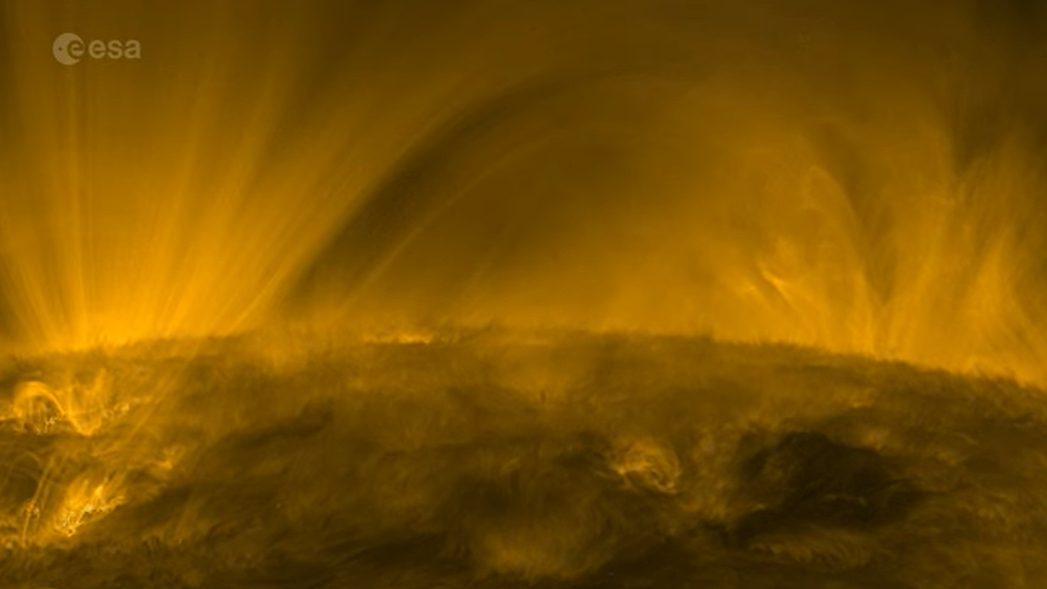
Underneath the arch of a huge coronal loop, a wealth of exotic solar phenomena active in the transition zone between the sun's lower atmosphere, the chromosphere, and the corona, have been recorded in this magical video by the European Space Agency's Solar Orbiter spacecraft.
The view, recorded by Solar Orbiter from a distance of a little over 43 million kilometers (26.7 miles) from the sun, reveals features on the solar surface that we could have only dreamed about seeing 10 years ago. That's because Solar Orbiter and its NASA counterpart, the Parker Solar Probe, are designed to observe the sun from a much closer vicinity than any other mission before them.
In fact, Solar Orbiter reached its closest point to the sun 10 days after shooting this video. Parker Solar Probe will reach its closest point, of a mere 6.9 million kilometers (4.3 million miles), on Christmas Eve later this year. This might still sound like a huge distance, but when you consider that the sun is 1.39 million kilometers (864,600 miles) across, it's not that far at all. Actually, , it's so darned close that Parker Solar Probe will skirt the edge of the corona and endure temperatures of 1,377 degrees Celsius (2,500 degrees Fahrenheit).
Related: Sun unleashes X-class solar flare, radio blackouts reported (video)

But back to Solar Orbiter. This video, filmed on Sept. 27, 2023 with the spacecraft's Extreme Ultraviolet Imager (EUI), shows several distinct types of features. The things to remember are that most activity on the sun is driven by the immense solar magnetism, and that much of it this activity involves temperatures so hot that it emits mostly in ultraviolet light. As the movie begins, the first notable feature you can see is a bright patch to the lower left. This is called "coronal moss." Commonly found at the base of coronal loops, which are magnetic loops that penetrate from the sun's visible surface (the photosphere) and form bridges across active regions that convey million-degree-hot plasma (ionized, or electrified, gas). The moss is so-named because when solar physicists first discovered it, it was a feature that appeared spongy.
Solar Orbiter's high-resolution vision, however, shows the moss instead to be a tangle of lace-like filaments of plasma that follow the jumble of magnetic field lines at the base of the loop, which is the site of an "active region." These regions are where sunspots can also be found, although sunspots are too cool to be seen in the ultraviolet light of this video. The brightest regions in the moss radiate in excess of a million degrees.
On the horizon of the solar limb we can see dark, spiky features. These hair-like structures are called spicules, and they are jets of plasma 300 kilometers (185 miles) across that can reach a height of 10,000 kilometers (6,200 miles) above the photosphere; they wave in time with the sun's gently oscillating magnetic field. Racing upwards at between 15 kilometers per hour and 110 kilometers per hour (9 miles per hour and 68 miles per hour), the millions of spicules that are present on the sun at any one time deposit huge amounts of plasma into the chromosphere and corona.
Twenty-two seconds into the video, something else happens. You'll see an eruption of cooler material that rises as a plume deep into the chromosphere before falling back down towards the photosphere. The violence and scale of this outburst is extraordinary; it might appear modest with respect to the rest of the sun, but that one eruption is larger than our entire Earth.
Toward the end of the video, it's possible to catch another elusive solar phenomenon: coronal rain. Despite the name, this is not water. It's made of droplets formed of huge clumps of plasma, 10,000 degrees Celsius (18,000 degrees Fahrenheit) warm, falling out of the coronal loop and back onto the photosphere. The coronal rain appears dark only because, in contrast to the million-degree-hot corona around it, the rain is comparatively cold, creating a contrast effect similar to the dark sunspots.
What happens on the sun has repercussions farther out in the solar system, too, as eventually much of the energy witnessed here in this video is unleashed into space by driving the solar wind, made of charged particles. This solar wind encounters spacecraft, planets and moons, interacting with them (this is what gives rise to the northern lights, for instance). Solar Orbiter and Parker Solar Probe are able to team up to study the solar wind, and it just so happened that, when Solar Orbiter shot this video, Parker Solar Probe was just 7.26 million kilometers (4.51 million miles) from the sun — Parker soon felt the solar wind that left the sun following the recording of this activity. With Solar Orbiter probing the source of the solar wind and where it gets its energy from, and Parker Solar Probe measuring the wind's gusts, solar physicists are able to get a clearer picture of how the solar wind forms and evolves as it flows away from our star.







